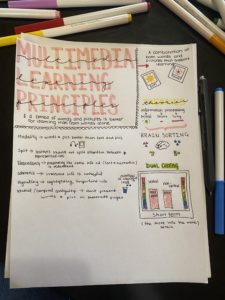SketchNote
I really love the idea of Sketch-noting as a way to capture and retain key information while learning. It allows learners a way to make their learning their own as they utilize their creativity and make note taking fun. Sketchnote incorporates art and text notes which rightfully follows the Multimedia Principles words and pictures are used simultaneously to build a deeper understanding of key concepts and ideas.
Here are the sketch notes I made while watching the video (What is Multimedia Learning? What is Multimedia? – Dr. Ray Pastore) provided for topic 3.

Which multimedia learning (MML) principles did Dr. Ray Pastore now follow in his video about MML principles? Why might an expert not be able to follow all the principles when creating a multimedia learning object?
In his video, Dr. Ray Pastore did follow the redundancy Principle, the embodiment principle, or the modality Principle.
The redundancy principle states that “presenting the same information two times increases cognitive load and interferes with learning (Pastore, 2018).” This could be the delivery of any two types of media that interfere with each other such as a text along with narration. As the same information is being delivered simultaneously in two verbal forms int becomes redundant and it can overwhelm learners. Pastore did not follow the criteria of this principle as he daily provided text along with narration without a non-verbal format in his video.
The embodiment principle states that some learners may not necessarily learn better with the speaker’s image appearing on the screen. Pastore did not follow this principle as his image was present throughout the video.
The modality principle is described as learners being able to learn better while words (narration) and pictures are better than words (text) and pictures. This allows learners to study and take in the information from an image while listening to the coinciding concept. Pastore did not follow this principle has he mainly provided only text and narration throughout the video (Pastore, 2018).
An expert may not be able to follow all the principles while creating a multimedia learning object as many of the principles can contradict each other. the principles are all dependent on what works best for the learner. Some learners may learn better from text along with pictures rather than narration and pictures which contradicts the modality principle. Some Learners may learn better when the speaker is in view which contradicts the embodiment principle. An expert could try to appease all the principles by providing click options, etc. but the principles may not all be satisfied at once as they contradict each other and it all depends on what works better for the learners that they are providing for.
Other thoughts or reflections on interactive and multimedia learning from any of these topics videos, readings, and H5P lab?
I was unable to attend the class lab which focused on H5P but as I made my way through the content of topic 3, I was able to navigate through the hands-on activity on my own. I think that H5P could be really useful to the creation of multimedia learning object as various tools are provided which allows something to benefit every kind of learner. Looking at the Interactive video tool, I began to think about how useful this could be for learners as they can reflect on and solidify what they are learning throughout the video or in a conclusion summary quiz at the end. Further, by incorporating questions throughout the video, it can help highlight what information may be important to retain.
Please enjoy my interactive video. In this video I experimented with interactive tools by inserting a text at the beginning and a reflective question at the end.
References:
Pastore, R. (Director). (2018). What is Multimedia Learning? What is Multimedia? [Video file]. Retrieved 2020, from https://www.youtube.com/watch?v=g-sknUVq1mk&feature=emb_title
Totorello, J. Westwoon, A. (TED-Ed). (2016). The Origins of Ballet – Jennifer Tortorello and Adrienne Westwood. [Video File]. Retrieved from: https://www.youtube.com/watch?v=OEekFTj5PvU

rmccue
Excellent reflections on sketchnoting and H5P.